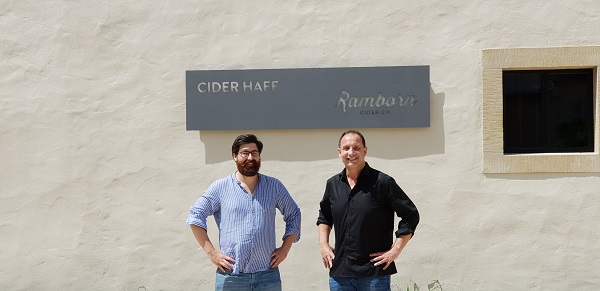 (L-R): Adie Kaye, Marco Hein of Ramborn;
Credit: John Chalmers
(L-R): Adie Kaye, Marco Hein of Ramborn;
Credit: John Chalmers
Three years ago, in May 2015, Ramborn Cider was launched.; this is a local cider, made with local apples, and revived a tradition of cider making in Luxembourg which had disappeared along with the orchards that grew the apples themselves.
Over the 20th century it is now estimated that Luxembourg lost nearly 90% of its apple trees. At that 2015 launch, Ramborn announced not only their new ciders, but also the start of several processes, including the renovation of an old farm and former cider press in Born, Commune de Mompach, now named “Cider Haff”, and also, in cooperation with the Mullerthall Nature Park project, the clearing and re-establishment of a number of fruit orchards which have fallen into disuse over the decades, and reaping the two benefits of an increased apple yield, and also the re-establishment of a number of important semi-open environments that create a whole mini ecosystem of some 5,000 species of flora and fauna, from mosses and lichens all the way through to the very rare and specialist Little Owl and larger birds of prey.
Moving forwards three years, the Ramborn brand is increasingly available in bars and supermarkets around Luxembourg, and the time has come to assess progress on the other two projects.
The “Cider Haff”, at 23 Duerfstross, L-6660 Born, has been transformed from an old disused shell to an impressive production, storage and visitor centre, providing employment and a new tourist potential to a relatively underdeveloped region of the country. The transformation took 2 years and a financial investment that, joked CEO Carlo Hein, “still makes me cry!” and demonstrates the seriousness with which the Ramborn team have approached the project.
The work on restoring the cultivated landscape has been equally impressive and includes both saving, where possible, old trees, and planting new ones. The saving of old trees typically involves removing the mistletoe parasite that has overtaken many of the trees, and cutting back the surrounding undergrowth, and can take anything from a couple of hours for a lightly infested apple tree to a whole day for a single mature pear tree. The estimate is that from planting a new sapling to full and seamless integration into the biotope takes approximately 31 years … much more in the case of the pear trees … so the benefits of saving the older stock are very clear.
It is also very clear that this is an investment from the heart, as well as the head. Carlo Hein moves from tree to tree in the orchards, explaining what condition it was in, when it was restored, or when it was planted, as though each one is his own child. Thus far, since 2015, Ramborn has recovered about 2000 trees, and is currently planting saplings at the rate of about 200 per year. As Carlo says of the saplings “although these trees will bear fruit in the next five or six years, meadow orchards take at least 31 years to reach maturity. After that they stay productive for at least another 50 years. For pear trees it takes even longer: they only reach maturity after 50 years, bearing fruit for over 200 more. What we’re planting now is not just for the next generation, but for generations after that!”.
Given that the apples are sourced from so many small providers, the products are not able to be labelled “Bio”, but as no insecticides or fertilisers are used on the trees, there is no leaching of chemicals into the water system. Once pressed, the remaining apple pulp is sent for conversion into bio fuel, and experiments are continuing into a diverse range of other uses that will complement the “cradle to cradle” ethos of the circular economy.
Given how “hot” the topics of “Sustainability”, “Circular Economy” and “Bio Diversity” are at the moment, it is particularly pleasing to see a Luxembourgish company that not only talks the talk, but also walks the walk. Investments in the environment on this scale are only able to be achieved by bringing all the actors into the play … individual citizens, SMEs, interest groups and governments alike.
The Ramborn project utilises all of these organs, and the benefits of this group investment will be felt by many generations to come. Perhaps this is the true meaning of the circular economy!








